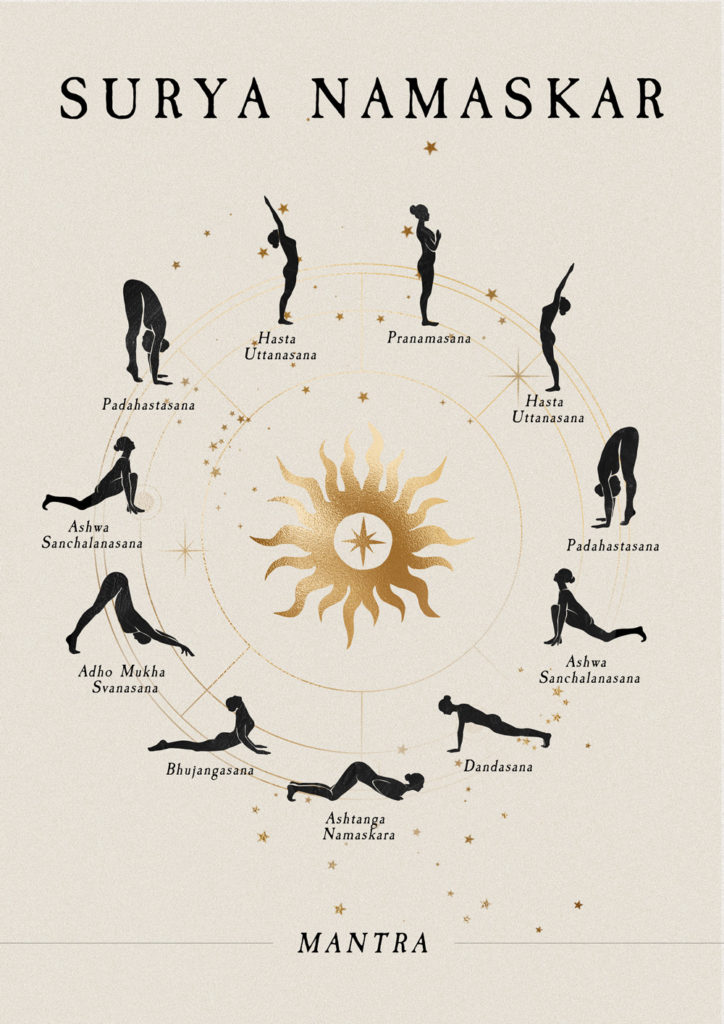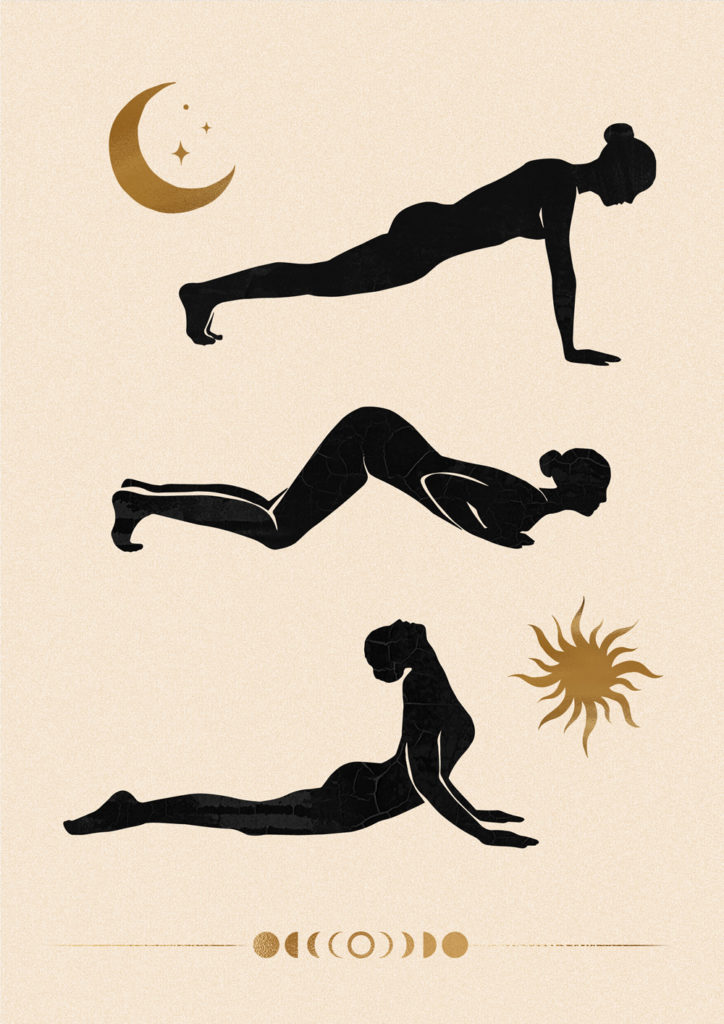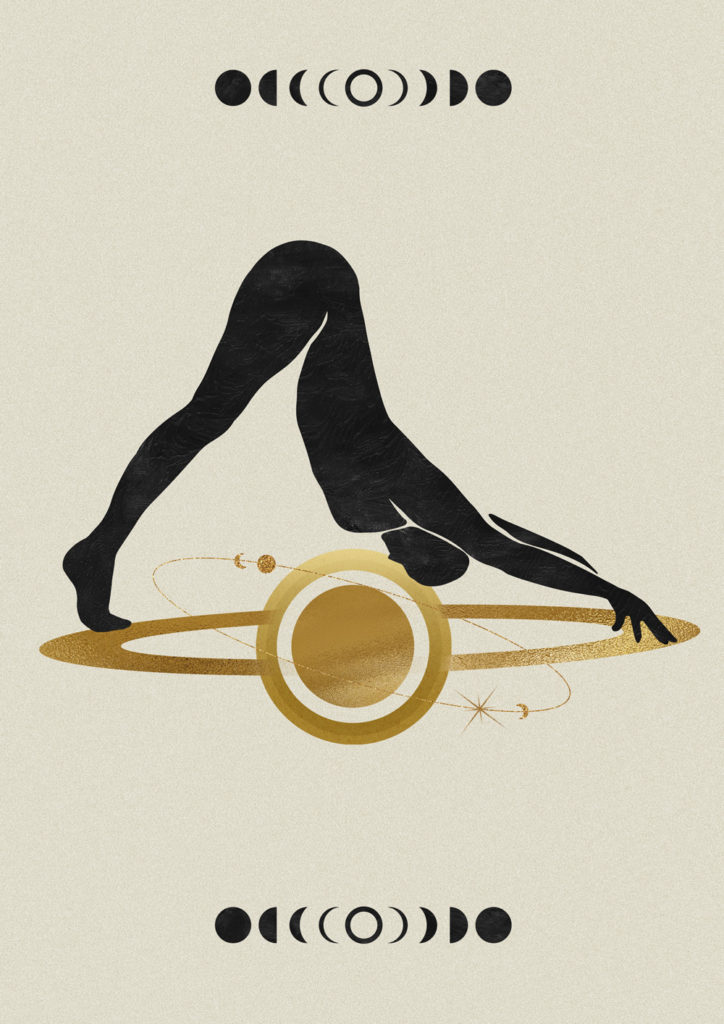If you only have 10 minutes to practice yoga, try this twelve-pose series of yoga poses called Sun Salutations.
The ancient yogic practice of Sun Salutations (Surya Namaskar) is an excellent way to wake up in the morning. This set of yoga poses, done in synchronization with the breath, called “vinyasa,” dates back over 2500 years. It was traditionally performed twelve times each morning, facing the East as the sun rose. This act was done as a form of respect and gratitude for the sun’s life-giving energy and seen as a way to prepare the body for the day ahead.
This set of poses is a progression of movements that begin and end with Mountain Pose (Tadasana). They include various stretches, forward bends, and backbend sequences that build heat and occur in a rhythmic cadency that aligns with your breathing. You can use movement as a form of meditation, and chanting mantras can help to focus the mind.
Chanting the Sun Salutation Mantras while doing the Surya Namaskar can help bring harmony to the body, breath and mind.
The key to a successful yoga practice is finding your own individual rhythm of movement and stillness. If you can flow in a way that aligns each breath with one body movement, then do so. However, if you need more time to get into a posture or want to linger in a stretch, that’s okay too. This is your practice, so make it work for you.
The benefits of Surya Namaskar are many:
• Strengthens the heart and lungs
• Improves digestion
• Increases energy levels
• Relieves stress and anxiety
• Aligns mind and body
• Boosts immunity
• Reduces inflammation
• Builds strength and flexibility
• Promotes balance and coordination
• Aids sleep
Yoga & Ayurveda
From an Ayurvedic perspective, sun salutations are beneficial for all three doshas. Sun salutation help to dispel the doshas from the spine and encourages Vyana Vatu (Vyana-Vayu translates as “outward moving air,” and its flow moves from the center of the body to the periphery.). However, each dosha should follow a unique set of guidelines when doing sun salutations.
Sun Salutations are most effective for Kapha doshas when done in the most active or vigorous way. However, they should build up their stamina slowly and practice regularly. Vata and Pitta doshas should do Sun Salutations at a slow and moderate pace, respectively. Pitta must be careful not to overwork themselves, and Vata should focus on spending more time holding the position than moving in and out of it.
Keep in mind that the doshas are never static, and their influence on us changes constantly. The body and mind are continually interacting and responding to our environment, the season, changes in lifestyle, and also any diseases or ailments. For example, irrespective of our constitution, if we have cold and congestion, we can benefit from a Kapha-reducing practice.

Sun Salutation Step-by-Step Instructions with Mantras
Pranamasana (Prayer pose)
Stand with your feet together, arms at your side, and distribute your weight evenly between your feet. Then turn your palms to face forward and let yourself come to a slow, steady breath. As you inhale, lift both arms up from the sides, and as you exhale, bring your palms together in front of the chest in a prayer position. (Anjali Mudra).
Mantra:
Om Mitraaya Namaha
Meaning:
One who is friendly to all.
Hasta Uttanasana (Raised arms pose)
Inhale and sweep your arms up and back, keeping the biceps close to the ears. Reach your heart and arms toward the sun. The goal is to stretch the whole body up from the heels to the tips of the fingers. To deepen this pose, push the pelvis forward slightly. Make sure you’re reaching up with the fingers instead of trying to bend backward.
Mantra:
Om Ravaye Namaha
Meaning:
The shining or the radiant one.
Padahastasana (Hand to Foot Pose)
Bend forward from the waist, keeping the spine erect. Exhale completely and bring the hands down to the floor beside the feet. You may bend the knees if necessary to bring the palms down to the floor. Now make a gentle effort to straighten the knees, keeping the hands fixed in this position.
Mantra:
Om Suryaya Namaha
Meaning:
The dispeller of darkness, responsible for generating activity.
Ashwa Sanchalanasana (Equestrian pose)
Inhale and push your right leg back. Bring the right knee to the floor and look up. Ensure that the left foot is exactly in between the palms.
Mantra:
Om Bhaanave Namaha
Meaning:
One who illuminates or the bright one.

Dandasana (Stick pose)
As you inhale, take the left leg back and keep your arms perpendicular to the floor. Bring your whole body into a straight line.
Mantra:
Om Khagaya Namaha
Meaning:
One who is all-pervading, one who moves through the sky.
Ashtanga Namaskara (Salute with eight parts or points)
Gently bring your knees down to the floor, exhale, and take the hips back slightly. Slide forward until your chest and chin are resting on the floor, then raise your posterior a little bit. The eight parts of your body that should touch the floor are both hands, both feet, both knees, and your chest and chin.
Mantra:
Om Pooshne Namaha
Meaning:
Giver of nourishment and fulfillment.
Bhujangasana (Cobra pose)
Inhale slide forward and lift your chest off the ground, keeping your elbows bent and shoulders away from your ears. Look up at the ceiling.
Mantra:
Om Hiranya Garbhaya Namaha
Meaning:
One who has a golden colored brilliance.
Adho Mukha Svanasana (Downward-Facing Dog)
Exhale and lift your hips up and back to come into Downward-Facing Dog. If possible, try and keep the heels on the ground and make a gentle effort to lift the tailbone up, going deeper into the stretch.
Mantra:
Om Mareechaye Namaha
Meaning:
Giver of light with infinite rays.

Ashwa Sanchalanasana (Equestrian pose)
Inhale, and bring the right foot forward, placing it between the two hands. The left knee will lower to the floor. Press down through the hips, and raise the gaze upward.
Mantra:
Om Aadityaaya Namaha
Meaning:
The son of Aditi, the cosmic divine mother.
Padahastasana (Hand to Foot Pose)
Exhale, bring the left foot forward. Keep the palms on the floor. You may bend the knees, if necessary. To deepen this yoga stretch, gently straighten the knees, and if you can, try and touch your nose to the knees. Keep breathing.
Mantra:
Om Savitre Namaha
Meaning:
One who is responsible for life.
Hasta Uttanasana (Raised arms pose)
Inhale deeply and roll your spine up. Raise your hands up overhead and bend backward a little bit, pushing your hips slightly outward. To deepen this yoga stretch, ensure that your biceps are beside your ears and focus on stretching up more rather than backward.
Mantra:
Om Arkaaya Namaha
Meaning:
One who is worthy of praise and glory.
Tadasana (Moutain Pose)
Exhale and return to Tadasana. Bring your hands into prayer position at your heart, or let them rest at your sides. You may continue with another Sun Salutation, or simply stay here for a few breaths, noticing how you feel.
Mantra:
Om Bhaskaraya Namaha
Meaning:
Giver of wisdom and cosmic illumination.
This completes one set of Surya Namaskar. Repeat the steps to complete the round, this time starting with taking the left foot behind in Ashwa Sanchalanasana (Equestrian pose), and bringing the right foot forward in Padahastasana (Hand to Foot Pose). Once done, you will have completed one round of Surya Namaskar.
Yoga Tips
If you find yourself confused about whether to inhale or exhale while doing yoga poses – A quick tip: in yoga, you typically inhale when lifting or expanding your body, and exhale when lowering or releasing your body.
If you catch yourself rushing through your day or your practice, try to intentionally lengthen your breath, especially your exhales. Let your movement follow the pace of your breath, and resist the urge to rush through the in-between-poses parts.
It is important to listen to your body and follow your instincts when it comes to yoga. Pushing yourself too hard can lead to injuries, fatigue, and lack of results. Ayurveda’s approach to yoga is to create a balance between the body and mind by addressing the particular needs of your unique temperament.
Practicing yoga can help develop the body and mind, but it is not a substitute for medicine. Always consult your doctor before practicing yoga, especially if you have a medical condition.
[…] mindfully nourishing your body with wholesome food, engaging in mindful movement practices such as yoga or meditation – you set yourself up for success on this journey toward holistic wellness that […]
[…] Sun Salutation (Surya Namaskar): This sequence is a great way to warm up the body, improve circulation, and promote energy and vitality. It involves moving through a series of poses, including Downward Facing Dog, Plank Pose, and Upward Facing Dog. […]